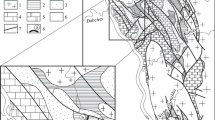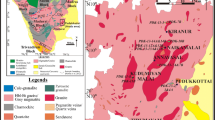Abstract
Rb-Sr whole-rock and mineral analyses are reported from Early Paleozoic sediments of the southern rim of the French Central Massif (Montagne Noire).
The sediments—mainly pelites, silt- and sandstones—can be separated into three different zones (A, B, and C) according to their varying degrees of deformation and transformation, which took place during the Hercynian (= Variscan) orogeny (Carboniferous).
For the least deformed, folded but not schistose, fossiliferous Lower Ordovician sediments (zone A), a scatter of the data points resulted, at least partly due to the varying amount of detrital muscovites, which did not equilibrate their Sr isotopes with those of the clay minerals.
Fossiliferous Middle Cambrian sediments (zone B), however, are colinear in an isochron plot. The rocks are also folded, and show a beginning schistosity in the pelitic layers. The age of 333±16 m.y. therefore does not correspond to the time of sedimentation, as one would expect from most of the interpretations given in the literature. It is, however, in close agreement with the stratigraphically known time of folding and anchimetamorphism.
The same result, within analytical error, of 326±17 m.y. was obtained for Lower Ordovician sediments (zone C), which show a schistosity not only in the pelites but also in some psammitic layers. As for the sediments of zone B, this result indicates open whole-rock systems for Rb and/or Sr during folding and anchimetamorphism.
Minerals extracted from psammites of zones B and C gave the following results: albite coincides with the isochrons; detrital muscovites do not coincide and yield ages of about 650 m.y. (Cadomian orogeny) for both zone B and C sediments; detrital chlorites from zone B sediments seem to be only partly reset by anchimetamorphism and therefore plot closer to the whole-rock isochron. From this it must be concluded that an increasing amount of these detrital micas could significantly shift the position of the total-rock points, as might be the case for zone A sediments.
From the whole-rock results of zone B and C sediments and the mineralogical and petrological changes during diagenesis and anchimetamorphism we conclude that many of the isochrons obtained from stratigraphically uncontrollable Precambrian sediments should be reinterpreted in favour of metamorphic and not sedimentary ages, especially if the metamorphism reached greenschist facies conditions.
Devonian and Cambrian limestones intercalated between the pelites, silstones and sandstones contain Sr of a variable and slightly radiogenic isotopic composition in contrast to the expected ancient sea water Sr. This fact is interpreted again in favour of open whole-rock systems during the postdepositional history of the rock, rather than primary scatter of ancient, radiogenic sea water Sr.
Similar content being viewed by others
References
Allsopp, H. L., Kolbe, P.: Isotopic age determination on the Cape Granite and intruded Malmesbury sediments, Cape Peninsula, South Africa. Geochim. Cosmochim. Acta 29, 1115–1130 (1965)
Allsopp, H. L., Ulrych, T. J., Nicolaysen, L. O.: Dating some significant events in the history of the Swaziland System by the Rb-Sr isochron method. Can. J. Earth Sci. 5, 605–619 (1968)
Arthaud, F.: Etude tectonique et microtectonique comparée de deux domaines hercyniens: Les nappes de la Montagne Noire (France) et l'anticlinorium de L'Iglesiente (Sardaigne). Ser. Geolg. Struct. 1 (1970)
Bell, K.: Age relations and provenance of the Dalradian Series of Scotland. Bull. Geol. Soc. Am. 79, 1167–1194 (1968)
Bishop, A. C., Bradshaw, J. D., Renouf, J. D., Taylor, R. T.: Stratigraphy and structure of part of West Finistère, France. Proc. Geol. Soc. London 1649, 122–127 (1968)
Bofinger, V. M., Compston, W.: A reassessment of the age of the Hamilton Group, New York and Pennsylvania, and the role of inherited radiogenic Sr87. Geochim. Cosmochim. Acta 31, 2353–2359 (1967)
Bofinger, V. M., Compston, W., Gulson, B. L.: A Rb-Sr study of the Lower Silurian State Circle Shale, Canberra, Australia. Geochim. Cosmochim. Acta 34, 433–445 (1970)
Bofinger, V. M., Compston, W., Vernon, M. J.: The application of acid leaching to be Rb-Sr dating of a Middle Ordovician shale. Geochim. Cosmochim. Acta 32, 823–833 (1968)
Boyer, F., Guiraud, R.: Observations nouvelles sur le passage du Cambrien a l'Ordovicien dans la Montagne Noire. Bull. Geol. France 515–522 (1964)
Charlot, R.: Geological studies in the Maroccan Precambrian. ECOG 72, Abstracts (1972)
Chaudhuri, S., Brookins, D. G.: The Rb-Sr whole-rock age of the Stearns Shale (Lower Permian), Eastern Kansas, before and after acid leaching experiments. Geol. Soc. Am. Bull. 80, 2605–2610 (1989)
Chaudhuri, S., Faure, G.: Geochronology of Keweenawan rocks, White Pine, Michigan. Ccon. Geol. 62, 1011–1033 (1967)
Clauer, N.: Utilisation de la méthode rubidium-strontium pour la datation de niveaux sédimentaires du Précambrien Supérieur de l'Adrar Mauretanien (Sahara occidental) et la mise en évidence de transformations précoces des mineraux argileux. Geochim. Cosmochim. Acta 37, 2243–2255 (1973)
Clauer, N., Bonhomme, M.: Datations Rb-Sr dans les schistes de Steige et la Série de Villé (Vosges). Bull. Serv. Carte Géol. Alsace Lorraine 23, 191–208 (1970)
Compston, W., Pidgeon, R. T.: Rubidium-Strontium dating of shales by the total-rock method. J. Geophys. Res. 67, 3493–3502 (1962)
Dasch, E. J.: Strontium isotopes in the weathering profiles, deep-sea sediments, and sedimentary rocks. Geochim. Cosmochim. Acta 33, 1521–1552 (1969)
Dunoyer De Segonzac, G.: The transformation of clay minerals during diagenesis and low-grade metamorphism: a review. Sedimentology 15, 281–346 (1970)
Esquevin, J.: Influence de la composition chimique des illites sur leur cristallinité. Bull. Centre Rech. Pau. S.N.P.A. 3, 147–153 (1969)
Fairbairn, H. W., Hurley, P. M., Card, K. J., Knight, C. J.: Correlation of radiometric ages of Nipissing diabase and Huronian metasediments with Proterozoic orogenic events in Ontario. Can. J. Earth Sci. 6, 489–497 (1969)
Faure, G., Kovach, J.: The age of the Gunflint Iron Formation of the Animikie Series in Canada. Geol. Soc. Am. Bull. 80, 1725–1736 (1969)
Frey, M.: The step from diagenesis to metamorphism in pelitic rocks during alpine orogenesis. Sedimentology 15, 261–279 (1970)
Gèze, B., Sitter, L. U., Trümpy, R.: Sur le sens de déversement des nappes de la Montagne Noire. Bull. Soc. Geol. France 6, 491–535 (1952)
Hurley, P. M., Pinson, W. H., Nagy, B., Teska, T. M.: Ancient age of the Middle Marker Horizon Onverwacht Group, Swaziland Sequence, South Africa. Earth Planet. Sci. Lett. 14, 360–366 (1972)
Kinsman, D. J. J.: Interpretation of Sr2+ concentrations in carbonate minerals and rocks. J. Sediment. Petrol. 39, 2, 480–508 (1969)
Kubler, B.: Les argiles, indicateurs de métamorphism. Rev. Inst. Franc. Petrole. 19, 1093–1112 (1964)
Lippmann, F.: Sedimentary carbonate minerals. Berlin-Heidelberg-New York: Springer 1973
Maxwell, D. T., Hower, J.: High grade diagenesis and low-grade metamorphism of illite in the Precambrian belt series. Am. Mineralogist 52, 843–857 (1967)
McDougall, I., Compston, W., Bofinger, V. M.: Isotopic age determinations on Upper Devonian Rocks from Victoria, Australia: A revised estimate for the age of the Devonian-Carboniferous boundary. Bull. Geol. Soc. Am. 77, 1075–1088 (1966)
Moorbath, S.: Evidence for the age of deposition of the Torridonian sediments of north-west Scotland. Scot. J. Geol. 5, 154–170 (1969)
Muffler, L. J. P., White, D. E.: Active metamorphism of Upper Cenozoic sediments in the Salton Sea-geothermal field and the Salton trough, southeastern California. Bull. Geol. Soc. Am. 80, 157–183 (1969)
Murthy, V. R., Beiser, E.: Sr-isotopes in ocean water and marine sediments. Geochim. Cosmochim. Acta 32, 1121–1126 (1968)
Obradovich, J. D., Peterman, Z. E.: Geochronology of the Belt Series, Montana. Can. J. Earth Sci. 5, 737–747 (1968)
Peterman, Z. E., Hedge, C. E., Coleman, R. G., Snavely, P. D.: 87Sr/86Sr ratios in some eugeosynclinal sedimentary rocks and their bearing on the origin of granitic magma in orogenic belts. Earth Planet. Sci. Lett. 2, 433–439 (1967)
Peterman, Z. E., Hedge, C. E., Tourtelot, H. A.: Isotopic composition of Sr in sea water throughout Phanerozoic time. Geochim. Cosmochim. Acta 34, 105–120 (1970)
Stille, H.: Grundfragen der vergleichenden Tektonik. Berlin: Bornträger 1924
Velde, B.: Experimental determination of muscovite polymorphs stabilities. Am. Mineralogist 50, 436–449 (1965)
Weaver, C. E.: Possible uses of clay minerals in search for oil. Bull. Am. Assoc. Petrol. Geologists 44, 1505–1518 (1960)
Weaver, C. E., Beck, K. C., Pollard, C. O. Jr.: Clay water diagenesis during burial: How mud becomes gneiss. Geol. Soc. Am. Spec. Paper 134 (1971)
Winkler, H. G. F.: Die Genese der metamorphen Gesteine. Berlin-Heidelberg-New York: Springer 1967
Whitney, P. R., Hurley, P. M.: The problem of inherited radiogenic strontium in sedimentary age determinations. Geochim. Cosmochim. Acta 28, 425–436 (1964)
Yoder, H. S., Eugster, H. P.: Synthetic and natural muscovite. Geochim. Cosmochim. Acta 8, 225–280 (1955)
York, D.: Least-squares fitting of a straight line. Can. J. Phys. 44, 1079–1086 (1966)
York, D., Farquhar, R. M.: The earth's age and geochronology, p. 109–115. Oxford: Pergamon Press 1972
Author information
Authors and Affiliations
Rights and permissions
About this article
Cite this article
Gebauer, D., Grünenfelder, M. Rb-Sr whole-rock dating of late diagenetic to anchimetamorphic, palaeozoic sediments in southern France (Montagne Noire). Contr. Mineral. and Petrol. 47, 113–130 (1974). https://doi.org/10.1007/BF00372113
Received:
Issue Date:
DOI: https://doi.org/10.1007/BF00372113




